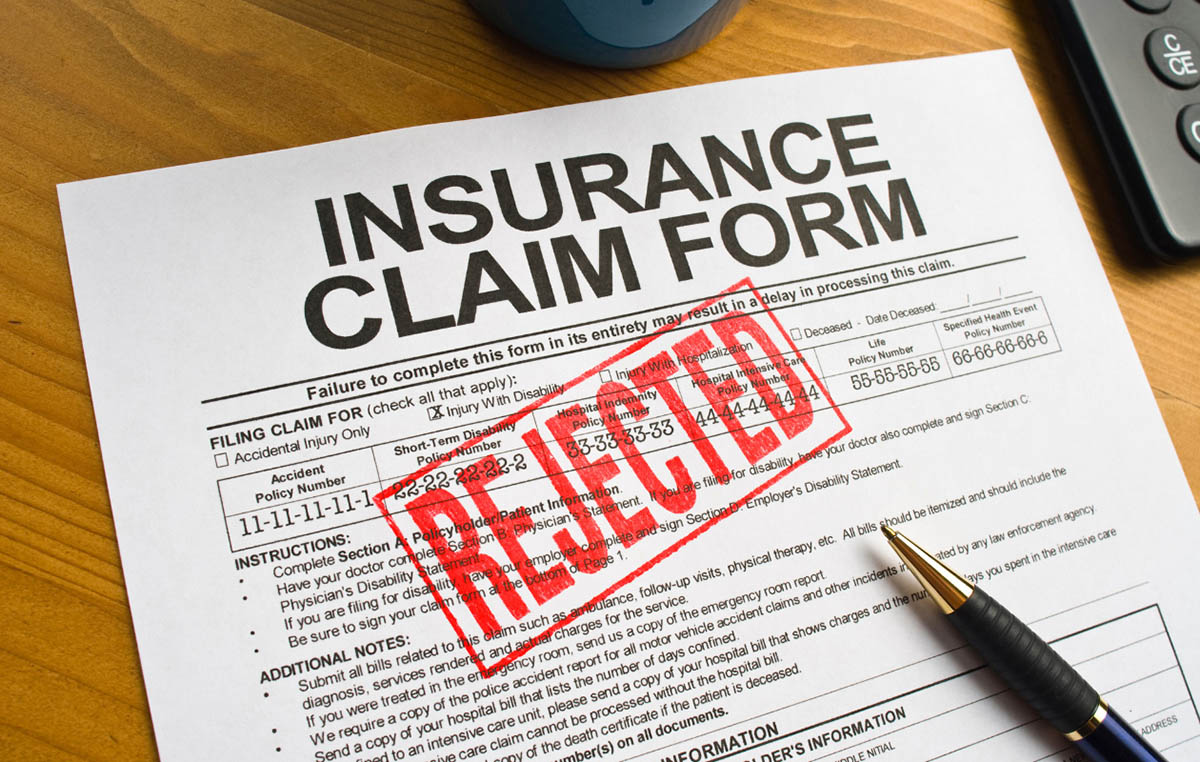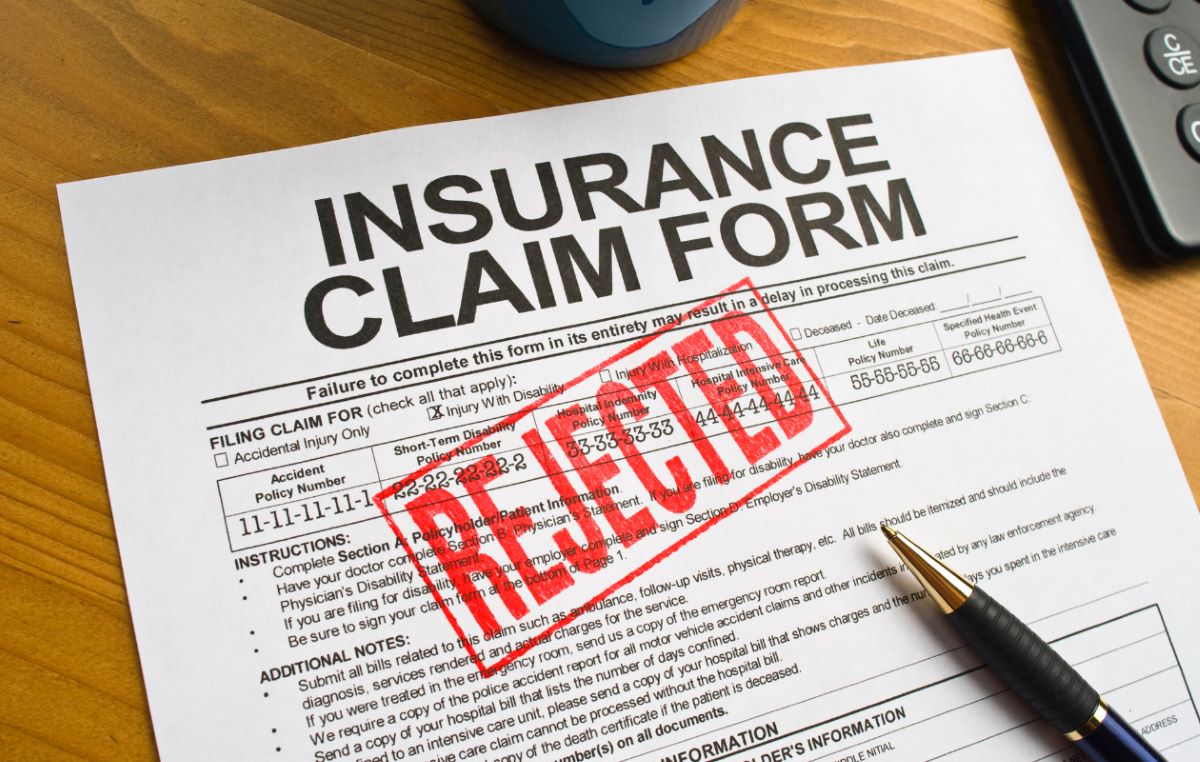

Finance
How To File A Bad Faith Insurance Claim
Modified: December 29, 2023
Learn how to file a bad faith insurance claim and protect your finance. Get expert tips and guidance to navigate the process effectively.
(Many of the links in this article redirect to a specific reviewed product. Your purchase of these products through affiliate links helps to generate commission for LiveWell, at no extra cost. Learn more)
Table of Contents
- Introduction
- Understanding Bad Faith Insurance Claims
- Signs of Bad Faith Insurance Practices
- Gathering Evidence for a Bad Faith Insurance Claim
- Notifying the Insurance Company
- Seeking Legal Assistance
- Filing a Complaint with the State Insurance Department
- Preparing for a Lawsuit
- The Bad Faith Insurance Claim Process
- Settlement Negotiations
- Going to Court
- Conclusion
Introduction
Dealing with insurance claims can be a stressful and overwhelming process, especially when your insurance company acts in bad faith. Bad faith insurance refers to situations where an insurance company unfairly denies, delays, or undervalues a valid claim. If you find yourself in this unfortunate situation, it’s important to know your rights and take appropriate action to protect yourself.
In this article, we will guide you through the process of filing a bad faith insurance claim. We will explore the signs of bad faith insurance practices and provide you with the necessary steps to gather evidence, notify the insurance company, seek legal assistance, and ultimately file a complaint with the state insurance department if needed. Additionally, we will discuss the process of preparing for a lawsuit, settlement negotiations, and potentially going to court.
It’s crucial to note that while this article serves as a general guide, each bad faith insurance claim may have its own unique circumstances and legal requirements. Consulting with an experienced attorney who specializes in insurance law is highly recommended to ensure your rights are protected and you receive the compensation you deserve.
Now, let’s delve into the world of bad faith insurance claims and empower you with the knowledge you need to navigate the process effectively.
Understanding Bad Faith Insurance Claims
Before diving into the process of filing a bad faith insurance claim, it’s essential to have a clear understanding of what constitutes bad faith insurance practices. Bad faith insurance occurs when an insurance company fails to fulfill its obligations to policyholders in an unfair or deceptive manner.
Insurance companies have a duty to act in good faith, meaning that they must handle claims promptly, fairly, and honestly. This includes thoroughly investigating claims, providing timely and reasonable payments, and communicating openly and transparently with policyholders.
There are several common examples of bad faith insurance practices:
- Unreasonable denial of claims: If an insurance company denies a claim without a valid reason or fails to provide a justified explanation, it may constitute bad faith. This could include dismissing a claim without conducting a proper investigation or wrongfully interpreting policy clauses to deny coverage.
- Undervaluing claims: Insurance companies may attempt to undervalue a claim by offering a settlement significantly lower than the actual value of the loss. This is an unfair practice that disregards the policyholder’s rights to receive proper compensation.
- Delayed claim processing: Unjustifiable delays in processing a claim can cause financial hardship and emotional distress for policyholders. Insurance companies should handle claims promptly and efficiently, ensuring that policyholders receive the necessary funds in a timely manner.
- Failure to communicate: An insurance company’s lack of communication or failure to provide timely updates on the status of a claim can be indicative of bad faith. Policyholders have the right to be informed and kept informed throughout the claims process.
- Rescission of coverage: Insurance policies can be retroactively canceled or rescinded by the insurance company. However, this should only happen in cases where the policyholder has demonstrated intentional fraud or misrepresentation. If an insurer cancels coverage without sufficient justification, it may be considered bad faith.
It’s important to note that bad faith insurance practices can occur with any type of insurance, including health insurance, auto insurance, homeowners insurance, or disability insurance. Regardless of the specific circumstances, policyholders have the right to fair treatment and proper compensation for their legitimate claims.
Now that you have a better understanding of bad faith insurance practices, let’s explore the signs that may indicate your insurance company is acting in bad faith.
Signs of Bad Faith Insurance Practices
Recognizing the signs of bad faith insurance practices is crucial when dealing with an insurance claim. By being aware of these indicators, you can protect your rights and take appropriate action if necessary. Here are some signs that may suggest your insurance company is acting in bad faith:
- Unreasonable delays: Insurance companies are expected to process claims in a reasonable amount of time. If you experience prolonged delays without a valid explanation, it could be a sign of bad faith.
- Lack of communication: Your insurance company should keep you informed throughout the claims process. If they fail to respond to your inquiries, provide updates, or keep you informed about the status of your claim, it may indicate bad faith behavior.
- Inadequate investigation: Insurance companies have a responsibility to conduct a thorough investigation into your claim. If they fail to gather evidence, overlook key information, or conduct a careless investigation that negatively impacts your claim, it could be a sign of bad faith.
- Unreasonable denial or undervaluing of claims: If your insurance company denies your claim without a valid reason or offers a settlement that is significantly below the actual value of your loss, it may be acting in bad faith.
- Changing policy interpretations: Insurance policies are legally binding contracts, and their terms and conditions should be interpreted consistently. If your insurance company changes its interpretation of policy clauses to your disadvantage, it could be a sign of bad faith.
- Lack of transparency: Your insurance company should provide clear and transparent explanations for its actions and decisions regarding your claim. If they fail to provide adequate justifications or refuse to share relevant information, it may suggest bad faith practices.
- Pressure to accept a low settlement: If your insurance company pressures you to accept a settlement that is significantly lower than what you are entitled to, it may be acting in bad faith. Remember, you have the right to fair compensation for your losses.
It’s important to keep detailed records of all interactions with your insurance company, including emails, letters, and phone conversations. These records will serve as crucial evidence if you decide to file a bad faith insurance claim. Furthermore, consulting with an experienced attorney who specializes in insurance law can help you navigate the situation and protect your rights.
In the next section, we will discuss the steps you can take to gather evidence and build a strong case for your bad faith insurance claim.
Gathering Evidence for a Bad Faith Insurance Claim
When filing a bad faith insurance claim, having strong evidence is crucial to support your case and prove that the insurance company acted in bad faith. By gathering relevant documentation and information, you can strengthen your claim and increase your chances of a successful outcome. Here are essential steps to follow when gathering evidence for your bad faith insurance claim:
- Review your insurance policy: Familiarize yourself with the terms, conditions, and coverage provided by your insurance policy. Understanding the specific provisions and obligations of the policy will help you identify any potential instances of bad faith behavior.
- Document all communication: Keep a comprehensive record of all communication with your insurance company. This includes written correspondence, emails, phone calls, and in-person meetings. Make note of dates, times, and the names of the individuals you interact with. These records serve as valuable evidence to demonstrate the insurance company’s actions or lack thereof.
- Retain copies of all documents: Keep copies of all relevant documents related to your claim, such as the initial policy, claim forms, medical bills, repair estimates, and invoices. These documents are essential to demonstrate the validity of your claim and the damages you have incurred.
- Gather supporting evidence: Collect any additional evidence that supports your claim. This may include photographs of the damages, witness statements, expert opinions, surveillance footage, or any other relevant documentation that proves the validity of your claim.
- Create a timeline: Organize your evidence chronologically to create a clear timeline of events. This will help establish the sequence of actions taken by the insurance company and highlight any unreasonable delays or inconsistencies.
- Obtain third-party opinions: Seek opinions from qualified professionals, such as contractors, medical professionals, or auto mechanics, who can provide expert statements or evaluations regarding the damages or injuries you have suffered. Their independent assessment can strengthen your case.
- Keep a journal: Maintain a journal detailing your experiences throughout the claims process. Record any conversations, frustrations, and emotional distress caused by the insurance company’s actions or lack of action. This can strengthen your claim by providing a deeper understanding of the impact of their bad faith practices on your life.
- Consult with an attorney: It’s highly recommended to seek legal advice from an experienced attorney who specializes in bad faith insurance claims. They can guide you through the evidence-gathering process, help assess the strength of your case, and provide the necessary expertise to fight for your rights.
Gathering strong evidence is a critical step in building a compelling bad faith insurance claim. By documenting your interactions, retaining copies of relevant documents, and obtaining supporting evidence, you can present a compelling case that demonstrates the insurance company’s failure to act in good faith.
In the next section, we will discuss how to appropriately notify the insurance company about your bad faith insurance claim.
Notifying the Insurance Company
Once you have gathered sufficient evidence to support your bad faith insurance claim, the next step is to officially notify the insurance company of your intentions. It’s important to communicate your dissatisfaction with their handling of your claim and assert your rights. Here’s what you need to know about notifying the insurance company:
- Express your concerns in writing: Compose a formal letter addressed to the insurance company’s claims department. Clearly state that you believe the company has acted in bad faith and include a summary of the evidence you have collected to support your claim. Be concise, precise, and professional in your communication.
- Include copies of relevant documents: Attach copies of any supporting documents that reinforce your case. This may include records of communication, policy documents, claim forms, invoices, estimates, and any other evidence that highlights the insurance company’s unfair practices.
- Set a reasonable deadline for response: Specifying a deadline for the insurance company to respond to your letter is important. It demonstrates your seriousness and allows you to take appropriate action if they fail to address your concerns within the designated timeframe.
- Send the letter using certified mail: To ensure proof of delivery and record the date of receipt, send the letter to the insurance company via certified mail with a return receipt requested. This will provide evidence that they have received your letter.
- Retain copies of all correspondence: Keep copies of the letter you sent, as well as any responses or communications received from the insurance company. These records will be valuable for future reference and potential legal proceedings.
- Follow-up if necessary: If the insurance company does not respond within the specified deadline or provides an unsatisfactory response, follow up with them. Consider escalating the matter to a supervisor or higher authority within the company to ensure your concerns are addressed.
- Consult with an attorney: If the insurance company continues to act in bad faith or fails to address your concerns, it may be necessary to consult with an attorney who specializes in bad faith insurance claims. They can provide guidance on next steps and may initiate legal action on your behalf if warranted.
By formally notifying the insurance company of your bad faith claim, you assert your rights and give them an opportunity to address the situation. It’s important to maintain clear communication and retain all documentation throughout this process, as it will contribute to the strength of your case.
In the next section, we will discuss the importance of seeking legal assistance in navigating a bad faith insurance claim.
Seeking Legal Assistance
Dealing with a bad faith insurance claim can be complex and overwhelming, which is why seeking legal assistance is highly recommended. An experienced attorney who specializes in bad faith insurance claims can provide valuable guidance and support throughout the process. Here are some reasons why you should consider seeking legal assistance:
- Expertise in insurance law: Attorneys specializing in bad faith insurance claims have in-depth knowledge and understanding of insurance laws and regulations. They can navigate the complexities of your case, interpret policy language, and ensure your rights are protected.
- Evaluation of your claim’s strength: A skilled attorney can assess the strength of your claim based on the evidence you have gathered. They can provide an objective evaluation and advice on how to proceed, helping you make informed decisions.
- Representation and negotiation: Your attorney can represent you in negotiations with the insurance company. Their expertise in dispute resolution and negotiation tactics can help level the playing field and increase your chances of obtaining a fair settlement.
- Courtroom advocacy: If settlement negotiations are unsuccessful, your attorney can skillfully represent you in court. They will present your case, cross-examine witnesses, and argue on your behalf to seek a favorable outcome at trial.
- Access to resources and network: Attorneys have access to a network of professionals, including expert witnesses, investigators, and consultants, who can provide additional support and strengthen your case.
- Knowledge of deadlines and legal procedures: Insurance claims have specific deadlines and legal procedures that must be adhered to. An attorney ensures that all necessary documents are filed correctly and submitted within the required timeframe, preventing potential issues that could jeopardize your claim.
- Peace of mind: Engaging an attorney to handle your bad faith insurance claim allows you to focus on other aspects of your life while knowing that a skilled legal professional is advocating for your rights and best interests.
When selecting an attorney, look for someone who specializes in bad faith insurance claims and has a successful track record in handling similar cases. Consider scheduling consultations to discuss your claim and assess their knowledge, experience, and compatibility with your needs.
Remember, having legal representation levels the playing field and increases your chances of obtaining a fair resolution to your bad faith insurance claim.
In the next section, we will discuss the process of filing a complaint with the State Insurance Department.
Filing a Complaint with the State Insurance Department
If your efforts to resolve your bad faith insurance claim directly with the insurance company have been unsuccessful, you have the option to file a complaint with your state’s insurance department. The state insurance department is responsible for regulating insurance companies and ensuring they comply with the applicable laws and regulations. Here’s what you need to know about filing a complaint:
- Research your state’s insurance department: Visit the website of your state’s insurance department to understand their role, responsibilities, and complaint process. Familiarize yourself with the specific requirements for filing a complaint in your state.
- Gather supporting documentation: Compile all relevant documents related to your bad faith insurance claim. This includes your policy, correspondence with the insurance company, evidence of their unfair practices, and any other pertinent information that strengthens your case.
- Complete the complaint form: Download or obtain the official complaint form from your state’s insurance department. Fill out the form accurately and provide all requested information. Be clear and concise in explaining the details of your bad faith claim.
- Attach supporting documents: Include copies of the supporting documents you have gathered with your complaint form. These documents will help substantiate your allegations and strengthen your case.
- Submit the complaint: Submit the completed complaint form along with the supporting documents to your state’s insurance department. Follow their instructions regarding submission methods, such as online forms, mail, or email.
- Follow up on the complaint: After submitting your complaint, stay in contact with the insurance department to inquire about the status of your case. Be prepared to provide any additional information or documentation they may request.
- Assistance from an attorney: Consider consulting with an attorney who specializes in bad faith insurance claims. They can guide you through the complaint process, ensure your rights are protected, and provide legal expertise if the matter escalates.
- State insurance department investigation: The insurance department will review your complaint and determine if the insurance company has engaged in bad faith practices. They may conduct an investigation and communicate with both parties involved to gather additional information.
- Resolution and enforcement: Depending on the outcome of their investigation, the insurance department may attempt to mediate a resolution between you and the insurance company. If a resolution cannot be reached, they may take further enforcement actions against the insurance company, such as fines or penalties.
Filing a complaint with the state insurance department is an important step in holding the insurance company accountable for their bad faith practices. The department’s involvement can provide an independent evaluation of your claim and potentially result in a resolution in your favor.
In the next section, we will discuss the process of preparing for a lawsuit in the event that a resolution cannot be reached through the complaint process.
Preparing for a Lawsuit
In some cases, despite your best efforts to resolve the bad faith insurance claim through negotiation, mediation, or filing a complaint with the state insurance department, a satisfactory resolution may not be achieved. In such situations, you may need to consider taking legal action and prepare for a lawsuit against the insurance company. Here are important steps to keep in mind when preparing for a lawsuit:
- Consult with an attorney: Engage the services of an experienced attorney who specializes in bad faith insurance lawsuits. They will assess the strength of your case, provide legal guidance, and represent your interests throughout the litigation process.
- Evidence collection: Review and gather all the evidence you have collected related to your bad faith claim. This includes documents, photographs, communications, expert opinions, and any other relevant information that supports your case. Share this evidence with your attorney, as they will help determine which are most compelling for your lawsuit.
- Establish damages: Identify and document the damages you have suffered as a result of the insurance company’s bad faith practices. This may include financial losses, emotional distress, inconvenience, or any other harm caused by their actions or inaction. Keep records and receipts to support your claims.
- Review insurance policy and applicable laws: Understand the terms and conditions of your insurance policy and the specific laws governing bad faith insurance in your jurisdiction. Your attorney will analyze these factors and help build your legal arguments based on the language of the policy and relevant statutes.
- Prepare a case strategy: Work closely with your attorney to develop a comprehensive and strategic approach for your lawsuit. They will guide you on the legal theories to pursue, the evidence to present, and the potential outcomes you can expect throughout the litigation process.
- Consider settlement options: Your attorney will explore settlement negotiations with the insurance company, both before and during the lawsuit. They will advocate for a fair and reasonable settlement based on your damages and the strength of your case. Be prepared to make informed decisions regarding settlement offers.
- Expert witnesses or consultants: Depending on the complexity of your case, your attorney may engage expert witnesses or consultants who can provide specialized knowledge or opinions that support your position. These professionals can help strengthen your case by providing credible testimony or analysis.
- Stay organized: Maintain a well-organized file of all documents, correspondence, and communications related to your lawsuit. This will help you and your attorney stay on top of important deadlines, facts, and developments throughout the litigation process.
- Follow your attorney’s guidance: Trust in the expertise and experience of your attorney. They will guide you through the legal process, provide advice on decisions, and represent your interests in court. It’s important to follow their guidance and collaborate closely with them throughout the lawsuit.
Preparing for a lawsuit requires careful attention to detail, collaboration with your attorney, and diligent organization of evidence. By engaging in a well-prepared legal strategy, you can maximize your chances of obtaining a favorable outcome in your bad faith insurance lawsuit.
In the next section, we will discuss the general process and potential avenues of resolution within a bad faith insurance claim.
The Bad Faith Insurance Claim Process
The bad faith insurance claim process can be complex and may vary depending on the specific circumstances of your case. However, there are general steps and potential avenues of resolution that are commonly followed. Here is an overview of the bad faith insurance claim process:
- Initial claim and denial: The process typically begins with you filing an initial claim with your insurance company. If they wrongfully deny, delay, or undervalue your claim, it may be an indication of bad faith practices.
- Evidence gathering: In order to support your claim, gather all relevant documentation, such as policy documents, correspondence, and evidence of damages. This will help build a strong case against the insurance company’s unfair practices.
- Notifying the insurance company: Officially notify the insurance company of your intentions to pursue a bad faith claim. This can be done through a formal letter that outlines your concerns and provides evidence of their bad faith practices.
- State insurance department complaint: If negotiations with the insurance company fail, you have the option to file a complaint with your state’s insurance department. They will review your complaint and communicate with both parties to investigate the matter further.
- Legal consultation: Seek legal advice from an attorney who specializes in bad faith insurance claims. They will evaluate the strength of your case, provide guidance on legal proceedings, and represent your interests throughout the process.
- Settlement negotiations: Your attorney may engage in settlement negotiations with the insurance company. This involves discussing potential resolutions, considering settlement offers, and working towards a fair and reasonable agreement.
- Potential mediation: In some cases, mediation may be pursued as an alternative to going to court. A neutral third party facilitates negotiations between you and the insurance company, aiming to reach a mutually acceptable resolution.
- Filing a lawsuit: If settlement negotiations or mediation fail to reach a satisfactory resolution, your attorney may advise you to file a lawsuit against the insurance company. This initiates the formal legal process that may lead to a judgment by a court.
- Discovery: During the litigation process, both parties engage in discovery, which involves exchanging relevant documents, gathering evidence, and engaging in written interrogatories or depositions.
- Trial or alternative dispute resolution: Depending on the circumstances, your case may proceed to trial where arguments are presented, evidence is examined, and a judgment is rendered. Alternatively, alternative dispute resolution methods like arbitration or mediation may be pursued.
- Appeals: If either party is dissatisfied with the outcome of the trial, they may have the option to file an appeal. This involves requesting a higher court to review the decision made in the initial trial.
- Enforcement of judgment: If a judgment is rendered in your favor, the insurance company will be legally obligated to comply with the terms of the judgment and provide the compensation or remedies ordered by the court.
It’s important to note that every bad faith insurance claim is unique, and the specific steps and resolution options may vary based on the laws of your jurisdiction and the circumstances of your case. Consulting with an experienced bad faith insurance attorney will provide you with the best guidance for navigating the process effectively.
In the next sections, we will discuss settlement negotiations and the potential of going to court in more detail.
Settlement Negotiations
Settlement negotiations are a common avenue for resolving bad faith insurance claims without going to court. This process involves discussions and negotiations between you and the insurance company, facilitated by your attorney. Here’s what you need to know about settlement negotiations in a bad faith insurance claim:
- Assessing the strength of your case: Before entering settlement negotiations, your attorney will evaluate the strength of your case based on the evidence and legal arguments. This assessment helps determine your bargaining position.
- Identifying a fair settlement amount: Your attorney will work with you to determine a fair and reasonable amount that adequately compensates you for the damages and losses you have suffered as a result of the insurance company’s bad faith practices.
- Submitting a demand letter: Your attorney will draft a demand letter that outlines your claim, presents supporting evidence, and states the settlement amount you are seeking. This letter serves as the starting point for negotiations.
- Counteroffers and negotiations: The insurance company may respond to your demand with a counteroffer. Your attorney will analyze their response and engage in back-and-forth negotiations to reach a satisfactory settlement amount.
- Considering non-monetary terms: In addition to financial compensation, settlement negotiations can also involve non-monetary terms. These may include policy changes, future coverage guarantees, or other actions that address the insurance company’s unfair practices or policy violations.
- Weighing the pros and cons: Throughout the negotiation process, your attorney will provide guidance on the advantages and disadvantages of potential settlement offers. They will help you understand the potential outcomes and advise on the best course of action based on your specific circumstances.
- Reaching a settlement agreement: If both parties are able to reach a mutually acceptable agreement, a settlement agreement will be drafted and signed by all parties involved. This agreement outlines the terms and conditions of the settlement and becomes legally binding upon execution.
- Maintaining confidentiality: Settlement agreements often include confidentiality clauses that prohibit either party from discussing the details of the settlement publicly. This protects the privacy and integrity of the agreement.
- Enforcement of the settlement: Once a settlement agreement is reached, the insurance company is legally obligated to fulfill its terms. If they fail to do so, you can pursue legal action to enforce the settlement and seek appropriate remedies.
- Consulting with your attorney: Throughout the settlement negotiation process, it is important to maintain open communication with your attorney. They will provide valuable guidance, advice, and strategy to protect your interests and help secure a favorable settlement.
Settlement negotiations can help you avoid the time, expense, and uncertainty of going to court. However, it is important to carefully consider settlement offers and consult with your attorney to ensure that they adequately address the damages and losses you have suffered as a result of the insurance company’s bad faith practices.
In the next section, we will discuss the potential of going to court if a satisfactory resolution cannot be reached through settlement negotiations.
Going to Court
If a satisfactory resolution cannot be reached through settlement negotiations, you may need to proceed with taking your bad faith insurance claim to court. Going to court allows for a formal legal process where a judge or jury can make a determination regarding your claim. Here’s what you need to know about the process of going to court in a bad faith insurance claim:
- Consultation with your attorney: Prior to proceeding to court, consult with your attorney to evaluate the strength of your case and discuss the potential outcomes and risks associated with litigation.
- Initiating the lawsuit: Your attorney will prepare and file a complaint against the insurance company, which outlines the legal basis for your claim, the damages you are seeking, and the relief you are requesting from the court.
- Discovery process: Both parties engage in the discovery process, where they exchange relevant documents, submit written interrogatories, conduct depositions, and gather evidence to prepare for trial. This phase allows each side to gather information and build their cases.
- Pre-trial motions: Prior to the trial, there may be various pre-trial motions filed by both parties. These motions address legal issues, evidence admissibility, or requests for summary judgment if the facts of the case are not in dispute.
- Settlement discussions during litigation: Even after filing a lawsuit, settlement discussions may still continue. Parties can engage in negotiations or participate in alternative dispute resolution processes such as mediation or arbitration to potentially reach a resolution.
- Trial preparation: Your attorney will thoroughly prepare your case for trial, including organizing evidence, identifying and preparing witnesses, and developing legal arguments to present the strongest possible case to the court.
- The trial: At the trial, both sides present their cases to a judge or jury. This includes opening statements, examination and cross-examination of witnesses, presentation of evidence, and closing arguments. The judge or jury then decides the outcome of the case.
- Judgment and remedies: If your case is successful, the court will render a judgment in your favor. The judgment will specify the amount of damages or other remedies awarded. The insurance company will be legally obligated to comply with the terms of the judgment.
- Appeals: In certain circumstances, either party may choose to appeal the court’s decision if they believe legal errors were made during the trial process. Appeals involve requesting a higher court to review and potentially overturn the judgment.
- Enforcement of the judgment: If the insurance company fails to comply with the judgment, you can take legal action to enforce it. This may involve obtaining additional court orders or pursuing further legal remedies to ensure the insurance company fulfills its obligations.
Going to court is a significant step in resolving a bad faith insurance claim. It allows for a formal legal process and a decision made by a judge or jury. Your attorney will guide you through each stage of the litigation process while emphasizing your legal rights and best interests.
It’s important to remember that litigation can be time-consuming, costly, and unpredictable. Consulting with a knowledgeable bad faith insurance attorney will help you understand the potential risks and benefits of going to court and make an informed decision based on your specific circumstances.
In the next section, we will conclude our discussion and summarize the key points of filing a bad faith insurance claim.
Conclusion
Filing a bad faith insurance claim can be a complex and challenging process. However, by understanding the concepts involved and following the appropriate steps, you can protect your rights and increase your chances of achieving a favorable outcome. Here are the key points to remember:
First, it’s important to understand what constitutes bad faith insurance practices, such as unreasonable claim denial, undervaluing claims, and delayed claim processing. Recognizing the signs of bad faith allows you to take appropriate action.
Gathering evidence is crucial in supporting your claim. Keep detailed records of all communication, retain copies of relevant documents, and gather any supporting evidence, such as photographs, expert opinions, and witness statements.
Notifying the insurance company about your bad faith insurance claim is the next step. Submit a formal letter outlining your concerns, backed by evidence, and set a reasonable deadline for response. If necessary, escalate the issue to the state insurance department and file a formal complaint.
Seeking legal assistance from an attorney who specializes in bad faith insurance claims is highly recommended. They will evaluate the strength of your case, guide you through the process, and represent your interests when dealing with the insurance company or in court.
Settlement negotiations provide an opportunity to resolve the claim without going to court. Assess the strength of your case, determine a fair settlement amount, and engage in negotiations with the insurance company. Your attorney will be instrumental in helping you navigate the negotiation process.
If a satisfactory resolution cannot be reached, you may need to consider going to court. Your attorney will initiate the lawsuit, engage in the discovery process, and prepare your case for trial. If successful, the court will render a judgment and the insurance company will be legally obligated to comply with it.
Remember, each bad faith insurance claim is unique, and the process may vary depending on jurisdiction and circumstances. Consulting with an experienced attorney will ensure your claim is handled properly and increase your chances of obtaining a fair settlement or judgment.
Dealing with bad faith insurance practices can be stressful, but with the right knowledge, evidence, and legal guidance, you can assert your rights, hold the insurance company accountable, and secure the compensation you deserve.














